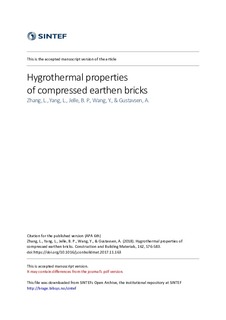| dc.contributor.author | Zhang, Lei | |
| dc.contributor.author | Yang, Liu | |
| dc.contributor.author | Jelle, Bjørn Petter | |
| dc.contributor.author | Wang, Yu | |
| dc.contributor.author | Gustavsen, Arild | |
| dc.date.accessioned | 2017-12-31T22:20:39Z | |
| dc.date.available | 2017-12-31T22:20:39Z | |
| dc.date.created | 2017-11-30T00:21:18Z | |
| dc.date.issued | 2018 | |
| dc.identifier.citation | Construction and Building Materials. 2018, 162 576-583. | nb_NO |
| dc.identifier.issn | 0950-0618 | |
| dc.identifier.uri | http://hdl.handle.net/11250/2473869 | |
| dc.description.abstract | The present study investigates the relationship between bulk density and hygrothermal behaviour of compressed earthen bricks. The experimental results show that the thermal conductivity linearly increases from 0.5228 W/(m K) to 0.9308 W/(m K) as the bulk density increases, and that the equilibrium moisture content increases with increasing relative humidity. Hysteresis effects are observed. When relative humidity changes, compressed earthen bricks usually reach an equilibrium in four days and it means compressed earthen bricks can be used to regulate indoor relative humidity. The hysteresis values of compressed earthen bricks with different bulk densities are close to each other, especially low relative humidity, as the results of Brunauer-Emmett-Teller (BET) show that samples with different bulk densities have similar porous structure including specific surface area (15.5008–16.2091 m2/g), micropore volume (0.000867–0.001221 cm3/g) and mesopore volume (0.030785–0.032239 cm3/g). Moreover, the hysteresis loops in this study belong to the type H3 hysteresis loops which indicate that there are some slitlike pores inside the matrix. | nb_NO |
| dc.description.sponsorship | Acknowledgements. This study is supported by The National Science Fund for Distinguished Young Scholars in China (Project No. 51325803). Lei Zhang thanks the financial support from China Scholarship Council and Research Council of Norway (Project No. 263919). The authors thank also The Research Centre on Zero Emission Neighbourhoods in Smart Cities (ZEN) and NanoLab at NTNU for the support in carrying out the experiments. The Research Council of Norway is acknowledged for the support to the Norwegian Micro- and Nano-Fabrication Facility, NorFab. | nb_NO |
| dc.language.iso | eng | nb_NO |
| dc.publisher | Elsevier | nb_NO |
| dc.rights | Attribution-NonCommercial-NoDerivatives 4.0 Internasjonal | * |
| dc.rights.uri | http://creativecommons.org/licenses/by-nc-nd/4.0/deed.no | * |
| dc.subject | Hygrothermal properties | nb_NO |
| dc.subject | Thermal conductivity | nb_NO |
| dc.subject | Hygroscopic behaviour | nb_NO |
| dc.subject | Porous structure | nb_NO |
| dc.subject | Compressed earthen brick | nb_NO |
| dc.title | Hygrothermal Properties of Compressed Earthen Bricks | nb_NO |
| dc.type | Journal article | nb_NO |
| dc.type | Peer reviewed | nb_NO |
| dc.description.version | acceptedVersion | nb_NO |
| dc.rights.holder | © 2018 Elsevier. All rights reserved. This is the authors' accepted and refereed manuscript to the article, post-print. Released with a Creative Commons Attribution Non-Commercial No Derivatives License. The final publication is available at https://doi.org/10.1016/j.conbuildmat.2017.11.163 | nb_NO |
| dc.subject.nsi | VDP::Technology: 500 | nb_NO |
| dc.source.pagenumber | 576-583 | nb_NO |
| dc.source.volume | 162 | nb_NO |
| dc.source.journal | Construction and Building Materials | nb_NO |
| dc.identifier.cristin | 1520568 | |
| dc.relation.project | Norges forskningsråd: 245963 | nb_NO |
| dc.relation.project | Norges forskningsråd: 263919 | nb_NO |
| cristin.unitcode | 7401,30,40,0 | |
| cristin.unitname | Arkitektur, byggematerialer og konstruksjoner | |
| cristin.ispublished | false | |
| cristin.fulltext | original | |
| cristin.fulltext | postprint | |
| cristin.qualitycode | 2 | |

